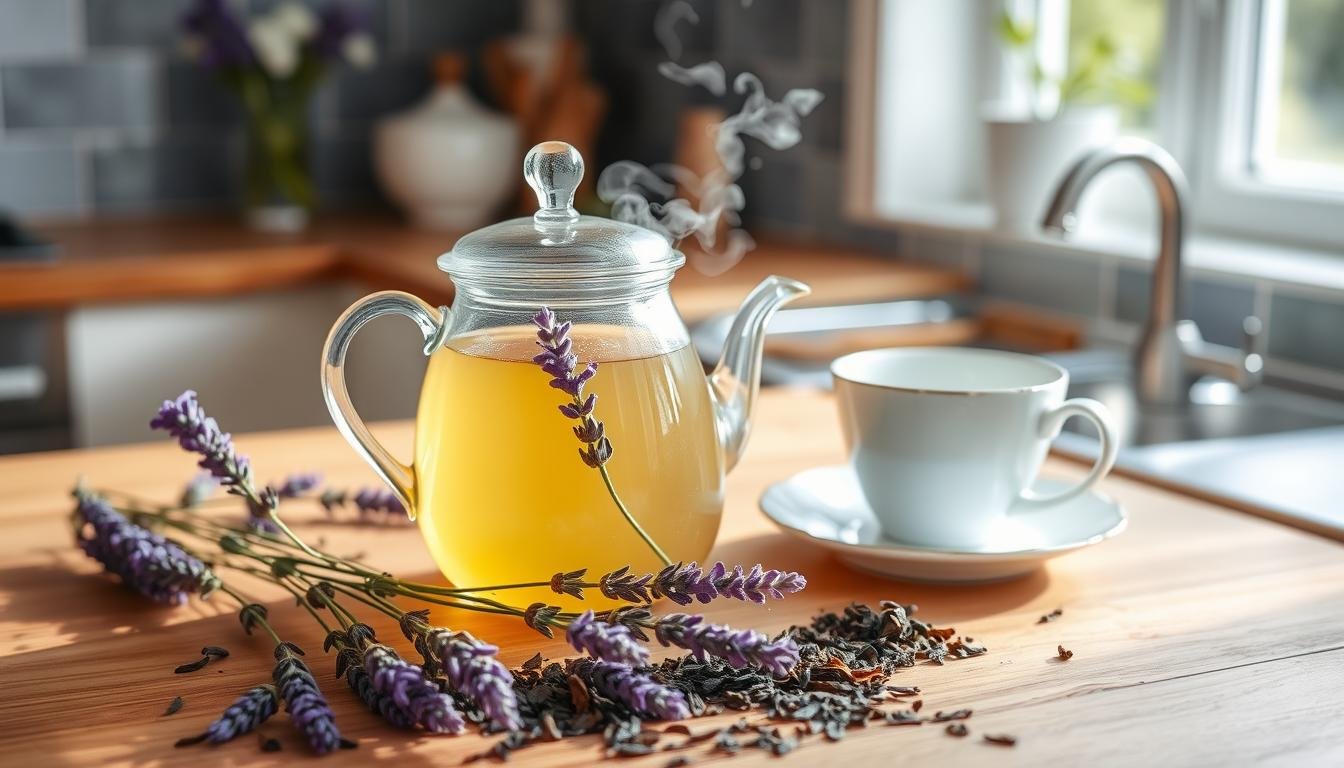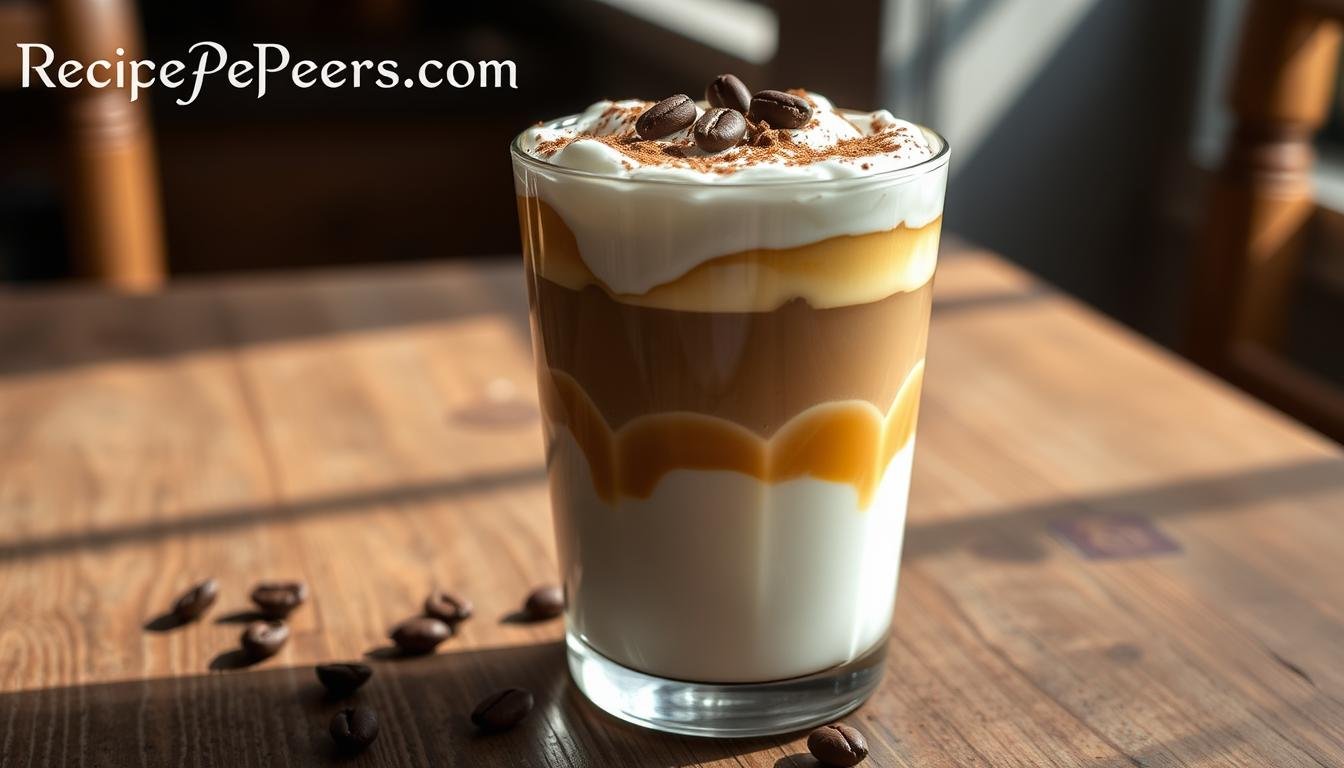Welcome to your ultimate guide for crafting the perfect Vietnamese Iced Coffee (Cà Phê Sữa Đá)! At Recipe Keepers (www.recipekeepers.com), we’re passionate about bringing authentic global flavors right into your kitchen. This Vietnamese iced coffee recipe is more than just a drink – it’s a cultural experience that combines bold robusta coffee with sweet condensed milk.
Our Vietnamese iced coffee recipe captures the essence of Southeast Asian coffee traditions. Each serving delivers a powerful caffeine kick with approximately 2 oz of concentrated coffee brewed through a traditional filter. Prepare to transform your morning routine with this refreshing beverage that balances strong coffee intensity with creamy sweetness.
What makes Vietnamese Iced Coffee unique? It’s all about the ingredients – robust Vietnamese robusta beans, precise brewing techniques, and the signature sweetened condensed milk. We’ll guide you through creating an authentic drink that packs 128 calories and delivers a delightful flavor profile that’ll transport you straight to the streets of Hanoi.
Get ready to become a home barista and master the art of Vietnamese iced coffee. Let’s dive into this delicious journey together!
Introduction to Vietnamese Coffee Culture and History
The story of Vietnamese coffee culture starts with a surprising twist. French colonists brought coffee to Vietnam in the 1880s. This changed the country’s farming and created a unique coffee tradition loved worldwide.
Vietnamese coffee traditions blend colonial influence with local creativity. During the French rule (1883-1954), coffee grew in Vietnam’s highlands. Places like the Central Highlands became key for coffee farming.
- Coffee first arrived with a single arabica tree in the 1850s
- By 1940, Vietnam was exporting around 2,000 tons of coffee annually
- Robusta beans now dominate, comprising 97% of Vietnam’s coffee production
The coffee scene in Vietnam changed a lot. After the Vietnam War, the government focused on coffee in 1986. This move helped the economy grow. The late 1980s and 1990s saw coffee areas grow by 21% each year.
| Period | Coffee Production Milestone |
|---|---|
| 1945 | 64.5% Arabica bean production |
| 1957 | Arabica production dropped to 1.7% |
| 2023-2024 | Projected production exceeding 31 million bags |
Today, Vietnam is the second-largest coffee exporter. It makes up about 20% of the world’s coffee market. Vietnamese coffee is more than a drink. It shows the nation’s strength, ability to adapt, and love for food.
Essential Equipment for Vietnamese Iced Coffee
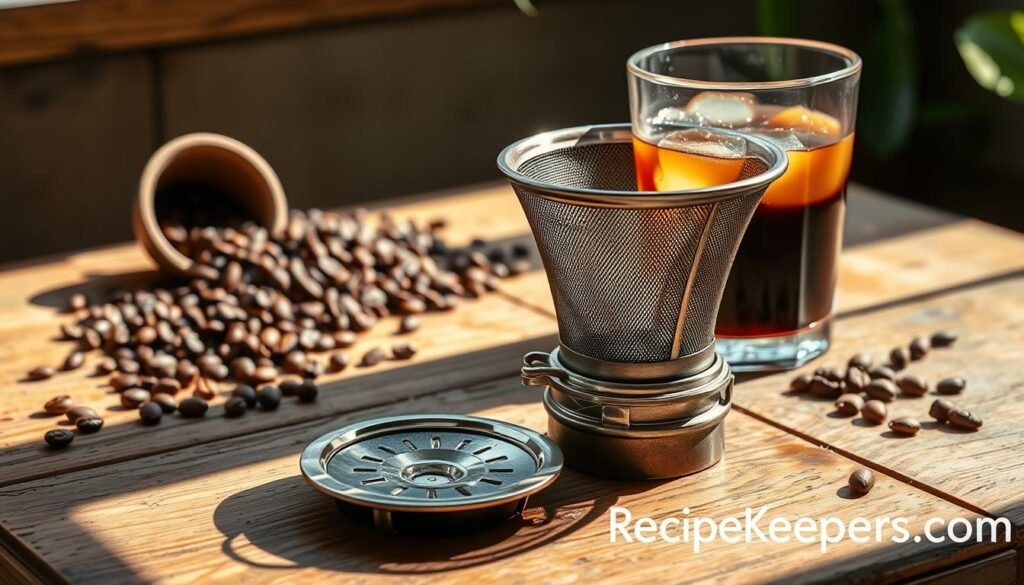
Making the perfect Vietnamese iced coffee needs special tools. The key is the Vietnamese coffee filter, or phin. It makes a strong coffee concentrate that’s amazing.
Here’s what you’ll need:
- Vietnamese Phin Coffee Filter: A traditional three-piece metal filter that slowly drips intense, rich coffee
- Heat-resistant glass: Essential for capturing your freshly brewed strong coffee concentrate
- Long-handled spoon: Perfect for stirring and mixing ingredients
- Ice cube trays: Larger cubes help prevent rapid dilution
When picking a Vietnamese coffee filter, consider these:
- Blue Phin Coffee Filter (around $10)
- Copper Cow Coffee Pour Over Set ($15)
- Nguyen Coffee Supply Original Phin Kit ($36)
Pro tip: Chill your glass in the freezer to keep your iced coffee cool. The phin filter brews in 3-5 minutes, making a concentrated coffee for a great iced drink.
Knowing your equipment is the first step to making Vietnamese iced coffee. With the right tools, you can make cafe-quality drinks at home!
Understanding Vietnamese Coffee Beans
Vietnamese coffee traditions are deeply rooted in the country’s unique approach to coffee cultivation. At the heart of this tradition lies the robust Robusta coffee beans. These beans set Vietnamese coffee apart from other global coffee cultures.
Vietnam is the world’s number one producer of Robusta coffee beans. They account for over 90% of the country’s coffee production. These beans are known for their distinctive characteristics:
- Higher caffeine content (2.7% compared to Arabica’s 1.5%)
- More intense and bitter flavor profile
- Comparable taste to dark chocolate or dark beer
The Central Highlands, particularly the Da Lat region, provide the perfect environment for growing these powerful Robusta coffee beans. This area’s unique climate and soil conditions contribute to the exceptional quality of Vietnamese coffee.
| Robusta Bean Characteristic | Specific Detail |
|---|---|
| Caffeine Content | 2.7% (nearly double Arabica) |
| Global Production Ranking | Number 1 for Robusta beans |
| Sugar and Fat Content | 60% less than Arabica |
The introduction of coffee to Vietnam by the French in the mid-19th century transformed the country’s agricultural landscape. Today, Vietnamese coffee continues to captivate coffee enthusiasts with its bold, uncompromising flavor. This flavor reflects the nation’s rich cultural heritage.
Whether served iced (ca phe da) or hot (ca phe nong), Robusta coffee beans remain the cornerstone of Vietnamese coffee traditions. They offer a truly unique and memorable drinking experience.
The Role of Sweetened Condensed Milk

Sweetened condensed milk is the heart of Vietnamese iced coffee. It turns a simple coffee into a rich, creamy treat. This ingredient came from a time when fresh dairy was hard to find in Vietnam.
The use of sweetened condensed milk in Vietnamese coffee started during the French colonial era. With no fresh milk around, people found that condensed milk’s sweetness and creaminess were perfect with their strong coffee.
- Typical serving: 1-2 teaspoons of condensed milk per cup
- Preferred brands: Longevity and Eagle Brand
- Caffeine content boost from Robusta beans: 2.2% to 2.7%
Our family’s secret? Play with the milk-to-coffee ratio. Mixing condensed milk with regular milk lets you adjust sweetness while keeping the Vietnamese coffee taste.
| Condensed Milk Characteristic | Details |
|---|---|
| First Invented | 1850s |
| Global Spread | Introduced through Vietnamese refugees post-Vietnam War |
| Cultural Significance | Staple in Vietnamese daily life and coffee culture |
Whether you love coffee or just want to try something new, knowing about sweetened condensed milk will make your Vietnamese iced coffee better. Get ready to make a cup that tells a story with every sip!
Vietnamese Iced Coffee Components
Making the perfect Vietnamese iced coffee means knowing its key parts. This traditional iced coffee drink mixes bold tastes and special ingredients. These make it unique among other iced coffee drinks.
The main parts of Vietnamese iced coffee are:
- Robusta coffee beans
- Sweetened condensed milk
- Large ice cubes
- Traditional Vietnamese coffee filter (phin)
Now, let’s look at the main ingredients and their roles in making a true Vietnamese iced coffee.
| Component | Characteristics | Typical Amount |
|---|---|---|
| Coffee | Robusta beans, medium-dark roast | 2 tablespoons ground coffee |
| Condensed Milk | Sweet, creamy | 2 tablespoons |
| Ice | Large cubes | 5-6 cubes |
Vietnam’s coffee culture loves strong, rich coffee. Robusta beans give a bold flavor that goes well with sweet condensed milk. When making Vietnamese iced coffee, use a traditional phin filter to get the best taste.
Pro tip: Pick a top-notch sweetened condensed milk like Longevity Gold for creamier texture. The milk’s richness balances the coffee’s strong taste, making a refreshing drink.
Step-by-Step Brewing Process
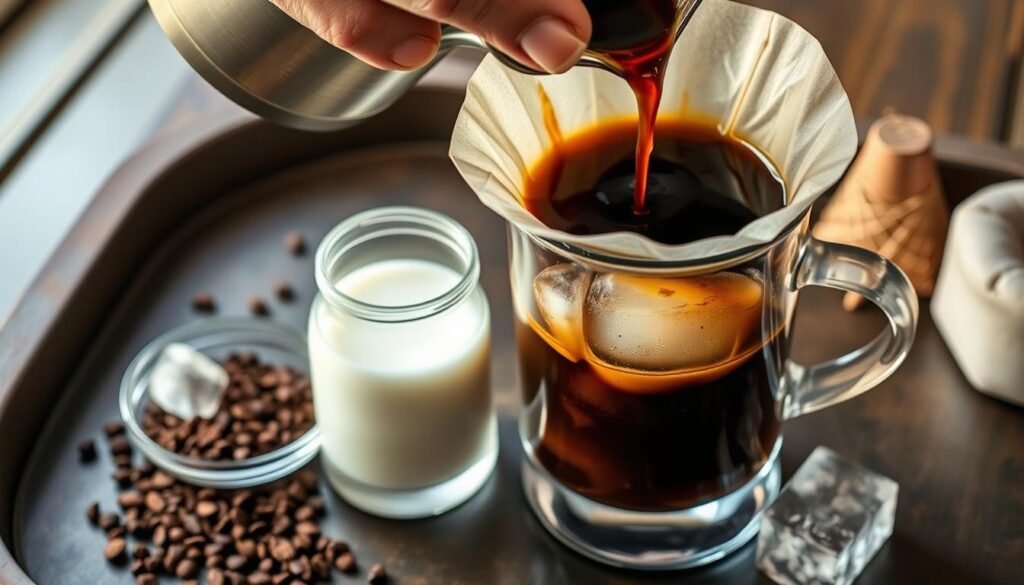
Making a true Vietnamese iced coffee recipe needs care and love. We’ll show you how to make the perfect cup with a traditional Vietnamese coffee filter. This way, every sip will feel like a trip to Hanoi’s busy streets.
First, get your key tools ready:
- Vietnamese coffee filter (phin filter)
- Dark roast Vietnamese coffee grounds
- Sweetened condensed milk
- Hot water
- Ice cubes
Now, let’s dive into the brewing steps. For the real taste, use Trung Nguyen coffee grounds.
- Start by setting up your Vietnamese coffee filter over a glass
- Put 2-3 tablespoons of ground coffee into the filter
- Tap the filter gently to even out the coffee
- Pour a bit of hot water (about 200°F) to “bloom” the coffee
- Wait 30 seconds for the CO2 to release and the flavor to improve
- Fill the rest of the filter with hot water
- Let the coffee drip slowly (4-5 minutes)
- Add 1-3 tablespoons of sweetened condensed milk
- Stir well and add ice for a cool drink
| Ingredient | Quantity | Purpose |
|---|---|---|
| Vietnamese Coffee Grounds | 2-3 tablespoons | Primary flavor base |
| Hot Water | 6-8 ounces | Extraction medium |
| Condensed Milk | 1-3 tablespoons | Sweetness and creaminess |
| Ice Cubes | As needed | Chilling and serving |
Pro tip: Try different coffee-to-milk ratios to find your ideal mix. Remember, taking your time makes the Vietnamese iced coffee experience even better!
Traditional Brewing Methods vs Modern Adaptations
Vietnamese coffee culture is at a crossroads of old and new. The classic Vietnamese coffee filter, known as the phin, connects coffee lovers to their roots.
Traditional brewing methods show the art of patience and precision:
- Slow drip technique using the traditional phin filter
- Manual brewing that allows coffee to extract gradually
- Precise temperature and pressure control
Modern adaptations are changing the iced coffee recipe world. Companies like OmniBev and Copper Cow Coffee are making Vietnamese coffee easier to make:
- Single-serving condensed milk tubes
- Organic, Fair Trade Arabica bean sourcing
- Streamlined brewing techniques
The modern coffee scene mixes tradition with ease. Some love the slow process of the traditional Vietnamese coffee filter. Others enjoy quick methods that keep flavors true.
Places like Phin Bar are hosting workshops and events. They celebrate both old and new brewing ways. This keeps Vietnamese coffee’s rich heritage alive while embracing new ideas.
Perfecting the Coffee-to-Milk Ratio
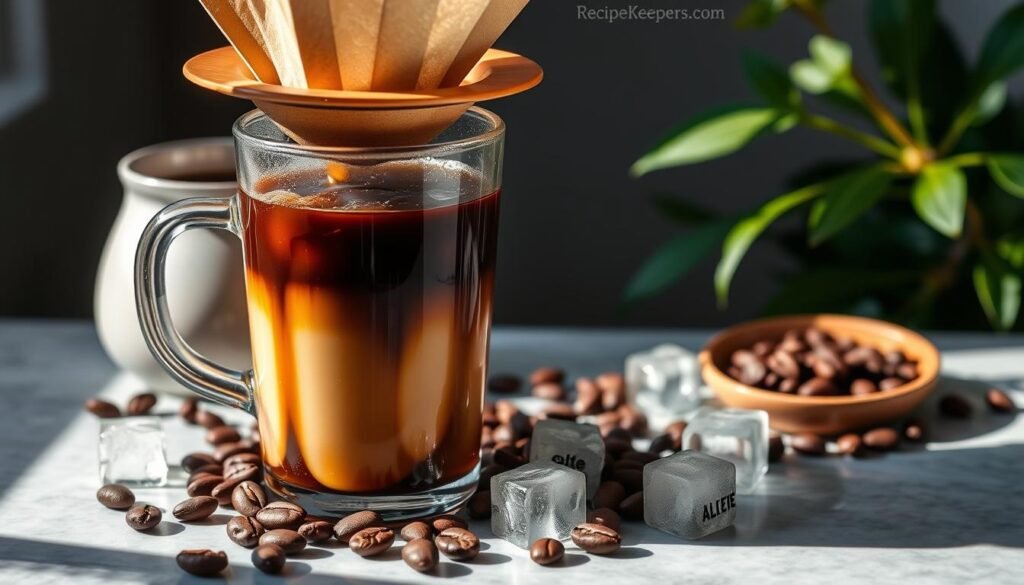
Making the perfect Vietnamese iced coffee is all about finding the right balance. The usual mix is 1:1.5 to 1:1.7 coffee to sweetened condensed milk. This means using about 20 grams of strong coffee and 30-35 grams of sweetened condensed milk.
Getting the coffee-to-milk ratio just right is key to a true Vietnamese iced coffee taste. Here are some tips to help you get it right:
- Start with 2 tablespoons of sweetened condensed milk per cup of coffee
- Adjust milk quantity based on personal sweetness preference
- Use a strong coffee concentrate for maximum flavor impact
For those who like precision, here’s a ratio guide:
| Coffee Type | Condensed Milk | Flavor Profile |
|---|---|---|
| Robusta Coffee Concentrate | 30-35 grams | Rich, Intense |
| Lighter Roast | 25-30 grams | Balanced, Smooth |
| Cold Brew Concentrate | 35-40 grams | Creamy, Mellow |
Pro tip: If your coffee is very strong, mix condensed milk with a bit of regular milk. This softens the sweetness and keeps the creamy texture. Remember, Vietnamese iced coffee is all about making it your own. There’s no one “right” way to enjoy it!
Common Mistakes to Avoid
Making the perfect Vietnamese iced coffee needs care and knowledge of the Vietnamese coffee culture. Many people make mistakes that ruin the strong coffee they want. These mistakes can make the coffee taste bad.
- Incorrect Bean Selection: Not all beans are created equal. Robusta beans are the heart of authentic Vietnamese coffee, offering a more intense flavor profile.
- Water Temperature Missteps: Brewing at the wrong temperature can destroy the nuanced flavors of your coffee.
- Over-Extraction Troubles: Letting coffee drip too long leads to bitter, unpalatable results.
When exploring Vietnamese coffee techniques, pay close attention to your brewing process. The ideal drip rate is 3-4 drops per second, ensuring optimal extraction without bitterness.
| Mistake | Consequence | Solution |
|---|---|---|
| Using Wrong Grind Size | Weak or Bitter Coffee | Use Medium-Coarse Grind |
| Improper Bean Storage | Stale Flavor | Store in Airtight Container |
| Incorrect Water Temperature | Poor Flavor Extraction | Use 212°F Water |
Storage matters a lot in keeping your coffee fresh. Keep your beans in an opaque, airtight container at room temperature. Try to use beans within a couple of weeks for the best taste.
Remember, mastering Vietnamese iced coffee is an art. Each try brings you closer to getting it right. Don’t get discouraged by early failures – keep practicing!
Serving and Presentation Tips
Making the perfect Vietnamese iced coffee is more than just taste. It’s about the art of presentation. Our family’s secret is turning each glass into a stunning experience. This captures the essence of Vietnamese coffee culture.
When serving these delightful iced coffee drinks, consider these expert presentation techniques:
- Choose tall, clear glasses to showcase the beautiful coffee layers
- Chill glasses beforehand for an extra-cool experience
- Garnish with coffee beans or a light dusting of cinnamon
- Pair with small pastries or fresh fruit for a complete café-style presentation
The ideal serving size for Vietnamese iced coffee is 4-6 ounces of cold brew mixed with 2-3 ounces of sweetened condensed milk. A pinch of salt can enhance the flavor.
| Presentation Element | Recommended Approach |
|---|---|
| Glassware | Tall, transparent glass |
| Temperature | Chilled glass, ice-cold coffee |
| Garnish Options | Coffee beans, cinnamon, fruit slice |
| Serving Suggestion | Accompany with light pastry |
Remember, we drink with our eyes first! Take a moment to craft a visually appealing presentation. Celebrate the rich tradition of Vietnamese coffee. Your guests will be impressed by both the taste and the stunning look of these refreshing summer beverages.
Variations and Creative Twists
Get ready to explore exciting iced coffee recipe twists for your summer refreshments! Vietnamese coffee is perfect for creative brewing techniques. It goes beyond the traditional method.
Let’s dive into some delicious variations that will elevate your coffee experience:
- Coconut Vietnamese Iced Coffee: Replace regular milk with creamy coconut milk for a tropical twist
- Egg Coffee (Cà Phê Trứng): A Hanoi specialty featuring a unique custard-like egg topping
- Coffee Smoothie: Blend Vietnamese coffee with banana and vanilla ice cream
- Yogurt Coffee: Mix coffee with yogurt for a milkshake-like beverage
Each variation brings something special to your summer refreshments. The key is experimenting and finding your personal favorite!
| Variation | Key Ingredients | Flavor Profile |
|---|---|---|
| Coconut Coffee | Robusta coffee, coconut milk | Tropical, smooth |
| Egg Coffee | Coffee, egg yolk, sugar | Creamy, rich |
| Coffee Smoothie | Coffee, banana, ice cream | Sweet, refreshing |
| Yogurt Coffee | Coffee, yogurt | Tangy, cool |
These innovative iced coffee recipes showcase the versatility of Vietnamese coffee. Robusta beans deliver strong flavors and low acidity. This makes them perfect for culinary creativity. Embrace the spirit of experimentation and transform your coffee routine!
Conclusion
Our journey through Vietnamese coffee traditions shows more than just a tasty drink. Vietnam is the second-largest coffee producer, making this Vietnamese iced coffee very special. Each sip connects you to a lively culinary heritage, thanks to robusta beans with twice the caffeine of arabica.
The traditional phin filter brewing method is key to Vietnamese iced coffee. It’s not just a drink; it’s a celebration of flavor and skill. The mix of strong coffee and sweet condensed milk is a unique experience. It’s perfect for coffee lovers and curious cooks alike, offering a peek into Vietnamese culinary traditions.
We encourage you to try new things and dive into the world of Vietnamese coffee. Share your experiences and creative twists at www.recipekeepers.com. Every cup tells a story of cultural connection and the joy of a well-made drink.
Your journey with Vietnamese iced coffee is just starting. It’s a delicious adventure into bold flavors and ancient brewing methods.

